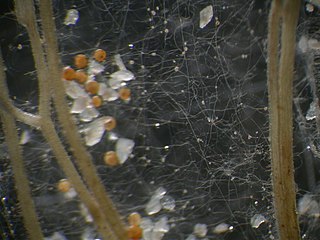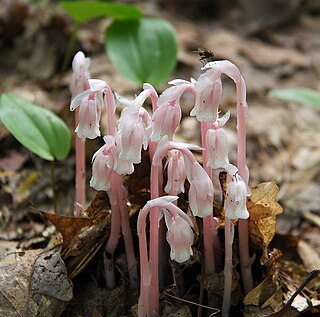
A mycorrhiza is a mutual symbiotic association between a fungus and a plant. The term mycorrhiza refers to the role of the fungus in the plant's rhizosphere, its root system. Mycorrhizae play important roles in plant nutrition, soil biology, and soil chemistry.

Howea forsteriana, the Kentia palm, thatch palm or palm court palm, is a species of flowering plant in the palm family, Arecaceae, endemic to Lord Howe Island in Australia. It is also widely grown on Norfolk Island. It is a relatively slow-growing palm, eventually growing up to 10 m (33 ft) tall by 6 m (20 ft) wide. Its fronds can reach 3 m (10 ft) long. The palm received the name "forsteriana" after Johann Reinhold Forster and Georg Forster, father and son, who accompanied Captain Cook as naturalists on his second voyage to the Pacific in 1772–1775.

Sympatric speciation is the evolution of a new species from a surviving ancestral species while both continue to inhabit the same geographic region. In evolutionary biology and biogeography, sympatric and sympatry are terms referring to organisms whose ranges overlap so that they occur together at least in some places. If these organisms are closely related, such a distribution may be the result of sympatric speciation. Etymologically, sympatry is derived from the Greek roots συν ("together") and πατρίς ("homeland"). The term was coined by Edward Bagnall Poulton in 1904, who explains the derivation.

Lord Howe Island is an irregularly crescent-shaped volcanic remnant in the Tasman Sea between Australia and New Zealand, part of the Australian state of New South Wales. It lies 600 km (320 nmi) directly east of mainland Port Macquarie, 780 km (420 nmi) northeast of Sydney, and about 900 km (490 nmi) southwest of Norfolk Island. It is about 10 km (6.2 mi) long and between 0.3 and 2.0 km wide with an area of 14.55 km2, though just 3.98 km2 of that comprise the low-lying developed part of the island.

Howea is a genus of two palms, H. belmoreana and H. forsteriana, both endemic to Lord Howe Island, Australia. H. forsteriana in particular is commonly grown as an indoor plant in the Northern Hemisphere, and the two species form the mainstay of the island's palm seed industry and more importantly its trade in newly germinated seedlings. The palms are also cultivated on Norfolk Island, where seeds are produced for export.

An arbuscular mycorrhiza(AM) is a type of mycorrhiza in which the symbiont fungus penetrates the cortical cells of the roots of a vascular plant forming arbuscules.

Helianthemum, known as rock rose, sunrose, rushrose, or frostweed, is a genus of about 110 species of flowering plants in the family Cistaceae. They are widely distributed throughout the Northern Hemisphere, especially in the Mediterranean.

Mycoremediation is a form of bioremediation in which fungi-based remediation methods are used to decontaminate the environment. Fungi have been proven to be a cheap, effective and environmentally sound way for removing a wide array of contaminants from damaged environments or wastewater. These contaminants include heavy metals, organic pollutants, textile dyes, leather tanning chemicals and wastewater, petroleum fuels, polycyclic aromatic hydrocarbons, pharmaceuticals and personal care products, pesticides and herbicides in land, fresh water, and marine environments. The byproducts of the remediation can be valuable materials themselves, such as enzymes, edible or medicinal mushrooms, making the remediation process even more profitable. Some fungi are useful in the biodegradation of contaminants in extremely cold or radioactive environments where traditional remediation methods prove too costly or are unusable due to the extreme conditions. Mycoremediation can even be used for fire management with the encapsulation method. This process consists of using fungal spores coated with agarose in a pellet form. This pellet is introduced to a substrate in the burnt forest, breaking down the toxins in the environment and stimulating growth.

Glomeromycota are one of eight currently recognized divisions within the kingdom Fungi, with approximately 230 described species. Members of the Glomeromycota form arbuscular mycorrhizas (AMs) with the thalli of bryophytes and the roots of vascular land plants. Not all species have been shown to form AMs, and one, Geosiphon pyriformis, is known not to do so. Instead, it forms an endocytobiotic association with Nostoc cyanobacteria. The majority of evidence shows that the Glomeromycota are dependent on land plants for carbon and energy, but there is recent circumstantial evidence that some species may be able to lead an independent existence. The arbuscular mycorrhizal species are terrestrial and widely distributed in soils worldwide where they form symbioses with the roots of the majority of plant species (>80%). They can also be found in wetlands, including salt-marshes, and associated with epiphytic plants.

Myco-heterotrophy is a symbiotic relationship between certain kinds of plants and fungi, in which the plant gets all or part of its food from parasitism upon fungi rather than from photosynthesis. A myco-heterotroph is the parasitic plant partner in this relationship. Myco-heterotrophy is considered a kind of cheating relationship and myco-heterotrophs are sometimes informally referred to as "mycorrhizal cheaters". This relationship is sometimes referred to as mycotrophy, though this term is also used for plants that engage in mutualistic mycorrhizal relationships.
Glomus aggregatum is an arbuscular mycorrhizal fungus used as a soil inoculant in agriculture and horticulture. Like other species in this phylum it forms obligate symbioses with plant roots, where it obtains carbon (photosynthate) from the host plant in exchange for nutrients and other benefits.
Archaeosporales is an order of fungi best known as arbuscular mycorrhiza to vascular land plants (Tracheophyta). But also form free living endocyte symbioses with cyanobacteria. The free living forms have a Precambrian fossil record back 2.2 Ga, well before evolution of Tracheophyta.

The Gibraltar Botanic Gardens or La Alameda Gardens are a botanical garden in Gibraltar, spanning around 6 hectares. The Rock Hotel lies above the park.
Microbial inoculants also known as soil inoculants or bioinoculants are agricultural amendments that use beneficial rhizosphericic or endophytic microbes to promote plant health. Many of the microbes involved form symbiotic relationships with the target crops where both parties benefit (mutualism). While microbial inoculants are applied to improve plant nutrition, they can also be used to promote plant growth by stimulating plant hormone production.

Mycorrhizal networks are underground hyphal networks created by mycorrhizal fungi that connect individual plants together and transfer water, carbon, nitrogen, and other nutrients and minerals.

Soil carbon storage is an important function of terrestrial ecosystems. Soil contains more carbon than plants and the atmosphere combined. Understanding what maintains the soil carbon pool is important to understand the current distribution of carbon on Earth, and how it will respond to environmental change. While much research has been done on how plants, free-living microbial decomposers, and soil minerals affect this pool of carbon, it is recently coming to light that mycorrhizal fungi—symbiotic fungi that associate with roots of almost all living plants—may play an important role in maintaining this pool as well. Measurements of plant carbon allocation to mycorrhizal fungi have been estimated to be 5 to 20% of total plant carbon uptake, and in some ecosystems the biomass of mycorrhizal fungi can be comparable to the biomass of fine roots. Recent research has shown that mycorrhizal fungi hold 50 to 70 percent of the total carbon stored in leaf litter and soil on forested islands in Sweden. Turnover of mycorrhizal biomass into the soil carbon pool is thought to be rapid and has been shown in some ecosystems to be the dominant pathway by which living carbon enters the soil carbon pool.

An ectomycorrhiza is a form of symbiotic relationship that occurs between a fungal symbiont, or mycobiont, and the roots of various plant species. The mycobiont is often from the phyla Basidiomycota and Ascomycota, and more rarely from the Zygomycota. Ectomycorrhizas form on the roots of around 2% of plant species, usually woody plants, including species from the birch, dipterocarp, myrtle, beech, willow, pine and rose families. Research on ectomycorrhizas is increasingly important in areas such as ecosystem management and restoration, forestry and agriculture.

Rhizophagus irregularis is an arbuscular mycorrhizal fungus used as a soil inoculant in agriculture and horticulture. In addition, it is one of the best mycorrhizal varieties of fungi available to mycoforestry, but as it does not produce fruiting bodies it "has virtually no market value as an edible or medicinal mushroom"
Falko Feldmann is a German biologist and practitioner of phytomedicine. He is coordinator of matters concerning approval and registration of active substances and agents for plant protection, including international cooperation on questions about European Plant Protection Laws. He also holds the post of Director of the Deutschen Phytomedizinischen Gesellschaft e.V. and is involved in a number of organisations and committees relevant to plant protection.
Mycorrhizae and climate change refers to the effects of climate change on mycorrhizae, a fungus which forms an endosymbiotic relationship between with a vascular host plant by colonizing its roots, and the effects brought on by climate change. Climate change is any lasting effect in weather or temperature. It is important to note that a good indicator of climate change is global warming, though the two are not analogous. However, temperature plays a very important role in all ecosystems on Earth, especially those with high counts of mycorrhiza in soil biota.

















